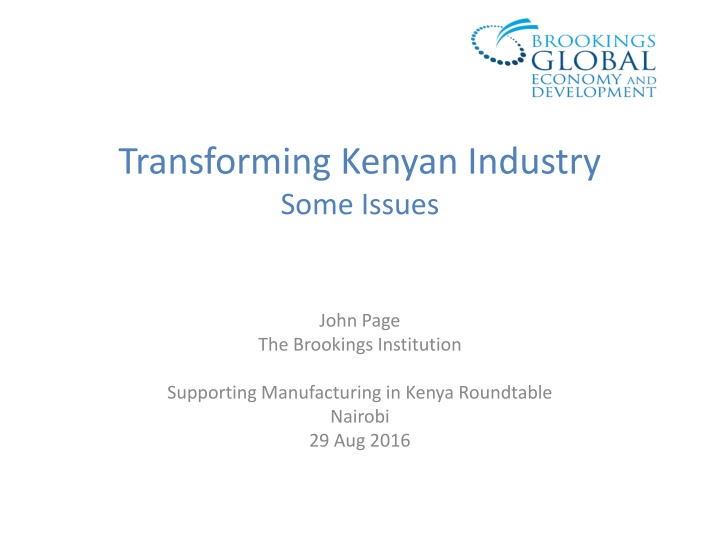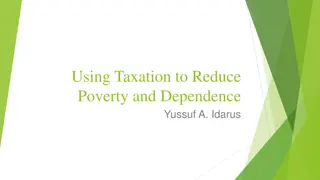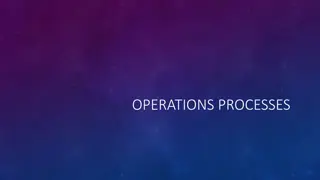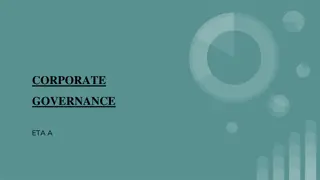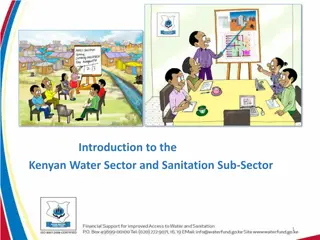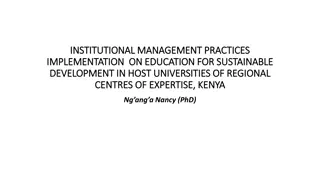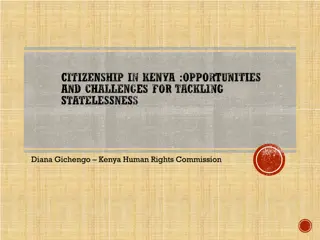Transforming Kenyan Industry
Kenya's manufacturing sector has struggled to grow over the past three decades, with its contribution to GDP remaining stagnant. Despite some early successes, industrial policies and outcomes have not led to sustained improvement. The country now has an opportunity to enhance its industrial location by focusing on infrastructure, skills development, and export strategies.
Download Presentation

Please find below an Image/Link to download the presentation.
The content on the website is provided AS IS for your information and personal use only. It may not be sold, licensed, or shared on other websites without obtaining consent from the author.If you encounter any issues during the download, it is possible that the publisher has removed the file from their server.
You are allowed to download the files provided on this website for personal or commercial use, subject to the condition that they are used lawfully. All files are the property of their respective owners.
The content on the website is provided AS IS for your information and personal use only. It may not be sold, licensed, or shared on other websites without obtaining consent from the author.
E N D
Presentation Transcript
Transforming Kenyan Industry Some Issues John Page The Brookings Institution Supporting Manufacturing in Kenya Roundtable Nairobi 29 Aug 2016
Ending Up Where it Started Industry in Kenya has Stagnated Manufacturing as a share of GDP has remained virtually constant over the past 30 years. In 2010 it was 11.2%, only modestly higher than the Africa-wide average of 10% And well below the value predicted for its level of income.
Benchmarking Kenyan Manufacturing 1995-2005 1975-1985 2.5 2 1.5 1 0.5 0 KEN TZA ZAF NGAMWI SEN CIV ZMBMUSSWZ ZWECMRGHA CAF BWA BDI GAB BDI
Industrial Policies and Outcomes Import substitution Early success and decline Structural Adjustment A short-lived recovery Investment Climate Reform Not yet a turning point
The Drivers of Industrial Location The basics Infrastructure and skills Policies and institutions Exports Successful industrialization episodes have been accompanied by export success Firms in low income countries increase their productivity by exporting Firm capabilities The tacit knowledge and working practices that affect both productivity and quality Capabilities can spill over to other firms through supply chain links Agglomerations Industrial clusters confer significant productivity gains Virtually everything we know about agglomeration economies comes from middle and high income countries
Some Indicators of Export Performance
Firm Capabilities: Different Neighborhoods Vietnam: Supplier Customer Competitor Kenya: Supplier Customer Competitor
A Window of Opportunity Kenya has a chance to break into the global market for industrial goods Changes in China Trade in tasks Industries without smokestacks But while some firms are competitive many others are not This places a premium on policies to raise firm-level productivity And there are too few firms This places a premium on attracting competitive firms
New Directions for Industrial Policy Investment climate reforms are necessary but not sufficient Exports, geography and capabilities must be linked Reforming the Investment Climate Agenda Mounting an Export Push Focus on infrastructure and skills development relevant to industry Support institutional development for FDI and SEZs Getting regulatory reform right Regulatory reform is important but not sufficient It has detracted from attention to infrastructure and skills High private costs of entry Long entry times and low persistence Kenya has been losing ground Especially in the EAC Entering global markets will need an East Asian style export push Broad ownership and effective institutions (leadership from the top) Policies and institutions affecting trade Trade related infrastructure and trade logistics
New Directions for Industrial Policy Capabilities and Clusters Building Firm Capabilities An export push is a major source of capabilities (demanding buyers; repeated relationships) Build effective FDI agencies Strengthen domestic value chain relationships New approaches to management training Supporting Clusters Agglomeration economies create a collective action problem SEZs are a means of creating clusters Bring Kenya s SEZs up to world class Strengthen the links between firms in the SEZ and domestic suppliers/purchasers
Some Issues for Discussion What are the key constraints keeping Kenya from moving from vision to action in implementing the industrialization strategy outlined in Vision 2030? What are the priority areas for public action to build the basics in public infrastructure and relevant skills? How can the investment climate agenda be modified to support the private sector more effectively? What are the regulatory constraints to greater competition in industry? In view of the priority given to exports in Vision 2030, what are the key policy instruments and institutional innovations needed to mount an export push? What are the priority public actions needed for building and implementing SEZs and industrial parks? What institutional innovations will support active FDI promotion? How can government help build linkages between local and foreign firms? How can greater policy coherence and coordination in implementation be achieved within government? What institutional framework is needed to strengthen government consultation and collaboration with the private sector?
